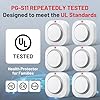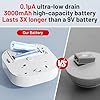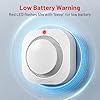A home should have at least one smoke detector on every level, including the basement. In addition, it is recommended to have a smoke detector in every bedroom. If you have a particularly large home, you may need more than one smoke detector on each level.
Contents
How many smoke detectors does the average home need?
The average home needs at least one smoke detector on each level, and one in each bedroom. However, it is recommended that you have two or more detectors in your home, depending on the size of your home. You should also have a smoke detector in your basement, near any sleeping areas, and near any potential fire hazards, such as the kitchen or near a fireplace.
Where should you place smoke detectors in your home?
Smoke detectors should be placed on every level of your home, both inside and outside of sleeping areas.
For the best protection, install detectors in the following locations:
- In or near every sleeping area
- On each level of your home, including the basement
- In or near common areas, such as family rooms and kitchens
- In or near laundry rooms and garages
- On the ceiling or high on a wall (at least four inches from the ceiling corners)
- At least 15 feet from any cooking appliance, such as a stovetop or oven
How often should you test your smoke detectors?
You should test your smoke detectors at least once a month to ensure they are in proper working condition. Smoke detectors are an important part of your home’s fire safety system, and they should be tested regularly to ensure they are working properly. If you have a battery-operated smoke detector, be sure to test the battery regularly as well.
What to do if your smoke detector goes off?
If your smoke alarm goes off, don’t ignore it! It is important to take immediate action to find out what is causing the alarm to sound. If there is smoke or fire, evacuate the building immediately. If you cannot determine the cause of the alarm, call the fire department. Do not re-enter the building until the fire department gives the all clear.
What type of smoke detector is best for your home?
There are three types of smoke detectors: ionization, photoelectric, and dual-sensor. Ionization smoke detectors are best at detecting fast-flaming fires, while photoelectric smoke detectors are best at detecting smoldering fires. Dual-sensor smoke detectors combine both ionization and photoelectric sensors.
Ionization smoke detectors have a small amount of radioactive material that ionizes the air in the detector. This ionization creates a current between two electrodes, and when smoke enters the detector, it disrupts the current, triggering the alarm.
Photoelectric smoke detectors have a light-sensitive sensor that uses a light-emitting diode (LED) to shine a light into the sensing chamber. When smoke enters the chamber, it scatters the light, and the sensor detects this change and triggers the alarm.
Dual-sensor smoke detectors use both ionization and photoelectric sensors to detect both fast-flaming and smoldering fires.
Smoke detectors should be installed on every level of your home, including the basement, and in every bedroom. They should be placed on the ceiling or high on a wall, at least four inches away from the nearest wall.
How to create a home fire safety plan?
A home fire safety plan is an important part of keeping your family safe in the event of a fire. Here are some tips on how to create a plan that will work for your family:
1. Choose a meeting place outside of your home where everyone will go in the event of a fire. This could be a neighbor’s house, a nearby park, or another safe location.
2. Make sure everyone in your family knows how to get to the meeting place. Practice evacuating your home so that everyone knows what to do and where to go.
3. Choose someone to be the designated “call person.” This person will be responsible for calling 911 in the event of a fire.
4. Make sure everyone in your family knows their full name, address, and phone number. This information will be helpful for the 911 operator.
5. Keep a list of emergency numbers near the phone. Include the numbers for the fire department, police, and your doctor.
6. Practice your home fire safety plan regularly. Review it with your family and make changes as needed.
What to do if there is a fire in your home?
If a fire starts in your home, it is important to act quickly to extinguish the fire and evacuate the premises. If the fire is small and contained, you may be able to extinguish it using a fire extinguisher. If the fire is larger or spreading, you should evacuate immediately and call 911. Once you are outside, do not re-enter the building until the fire has been extinguished and it is safe to do so.
Summary
When it comes to protecting your home from fire, having the right number of smoke detectors is key. But how many do you really need? The answer may surprise you.
According to the National Fire Protection Association, you should have at least one smoke detector on every level of your home, as well as in every bedroom. But that’s the bare minimum.
Ideally, you should have a smoke detector in every room of your home, as well as one in every hallway. And if you have a particularly large home, you may need even more detectors to ensure that all areas are adequately covered.
The bottom line is that when it comes to smoke detectors, more is better. So make sure you have enough to keep your family safe.



















